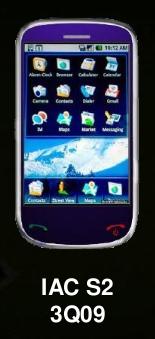That's right, folks. 2009 is a big year for NVIDIA's smaller-than-a-dime Tegra chips, and it's a big year for Android as well. For those who haven't followed Tegra news, the two system-on-a-chip products (the Tegra 600 series and Tegra APX) are together capable of full HD capture at 720p, and playback at 1080p. The results can be seen on an external Hi-Def display in Noah's video from the 2008 NVision Conference in San Jose. Check out the ultra-responsive 3D UI.
Today's announcement goes beyond introducing the killer combination of Android and Tegra. NVIDIA says that the world's first $99 HD MID is coming. It runs Windows CE and promises ten times the battery life of Atom-based Mobile Internet Devices. Not to mention that they're pushing this "product" as always on, always connected while promising days between charges. The $99 deal seems to be based on a theoretical device that the Tegra chips are likely to make possible - thanks to its cost and energy efficiency. Android phones with Tegra under the hood should see significantly improved battery life over say... the G1.
Along with the press release came projections for the growth of the Google-Phone market. I'm not entirely sure what kind of research the graphs I saw are based on. But if NVIDIA's call is correct, we'll find Android on half as many smartphones sold in 2010 as those running Windows Mobile. By 2012, Android-powered devices will outsell Win-Mo products by approximately ten million units.
You can see what looks to be a mock-up of an Android / Tegra device below. Two Windows CE models - with Tegra specs - can be seen here. I don't believe the phones to be actual products, but rather example platforms for conceptually selling the Tegra chips. As Noah points out, these industry announcements can be tricky to decipher. Hype makes the (business) world go 'round.
